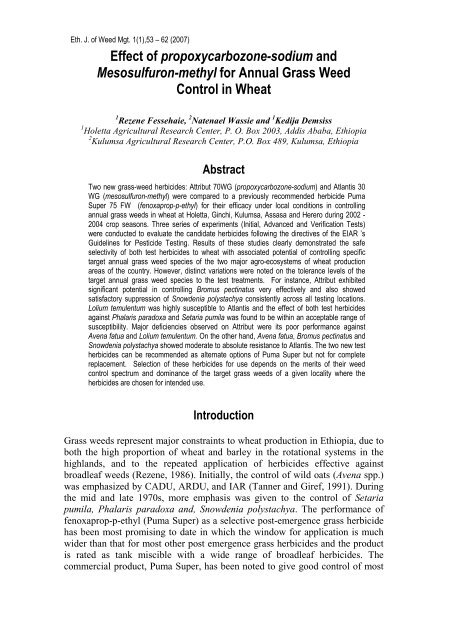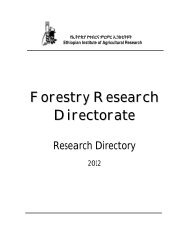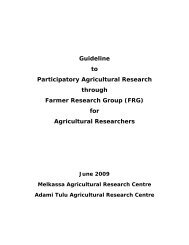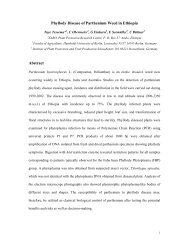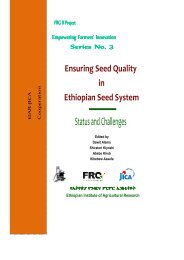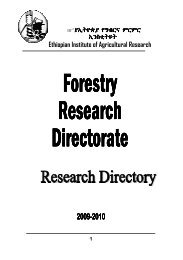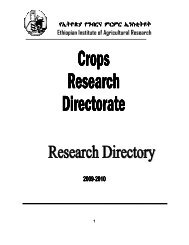Effect of propoxycarbozone-sodium and Mesosulfuron-methyl for ...
Effect of propoxycarbozone-sodium and Mesosulfuron-methyl for ...
Effect of propoxycarbozone-sodium and Mesosulfuron-methyl for ...
You also want an ePaper? Increase the reach of your titles
YUMPU automatically turns print PDFs into web optimized ePapers that Google loves.
Eth. J. <strong>of</strong> Weed Mgt. 1(1),53 – 62 (2007)<br />
<strong>Effect</strong> <strong>of</strong> <strong>propoxycarbozone</strong>-<strong>sodium</strong> <strong>and</strong><br />
<strong>Mesosulfuron</strong>-<strong>methyl</strong> <strong>for</strong> Annual Grass Weed<br />
Control in Wheat<br />
1 Rezene Fessehaie, 2 Natenael Wassie <strong>and</strong> 1 Kedija Demsiss<br />
1 Holetta Agricultural Research Center, P. O. Box 2003, Addis Ababa, Ethiopia<br />
2 Kulumsa Agricultural Research Center, P.O. Box 489, Kulumsa, Ethiopia<br />
Abstract<br />
Two new grass-weed herbicides: Attribut 70WG (<strong>propoxycarbozone</strong>-<strong>sodium</strong>) <strong>and</strong> Atlantis 30<br />
WG (mesosulfuron-<strong>methyl</strong>) were compared to a previously recommended herbicide Puma<br />
Super 75 FW (fenoxaprop-p-ethyl) <strong>for</strong> their efficacy under local conditions in controlling<br />
annual grass weeds in wheat at Holetta, Ginchi, Kulumsa, Assasa <strong>and</strong> Herero during 2002 -<br />
2004 crop seasons. Three series <strong>of</strong> experiments (Initial, Advanced <strong>and</strong> Verification Tests)<br />
were conducted to evaluate the c<strong>and</strong>idate herbicides following the directives <strong>of</strong> the EIAR ’s<br />
Guidelines <strong>for</strong> Pesticide Testing. Results <strong>of</strong> these studies clearly demonstrated the safe<br />
selectivity <strong>of</strong> both test herbicides to wheat with associated potential <strong>of</strong> controlling specific<br />
target annual grass weed species <strong>of</strong> the two major agro-ecosystems <strong>of</strong> wheat production<br />
areas <strong>of</strong> the country. However, distinct variations were noted on the tolerance levels <strong>of</strong> the<br />
target annual grass weed species to the test treatments. For instance, Attribut exhibited<br />
significant potential in controlling Bromus pectinatus very effectively <strong>and</strong> also showed<br />
satisfactory suppression <strong>of</strong> Snowdenia polystachya consistently across all testing locations.<br />
Lolium temulentum was highly susceptible to Atlantis <strong>and</strong> the effect <strong>of</strong> both test herbicides<br />
against Phalaris paradoxa <strong>and</strong> Setaria pumila was found to be within an acceptable range <strong>of</strong><br />
susceptibility. Major deficiencies observed on Attribut were its poor per<strong>for</strong>mance against<br />
Avena fatua <strong>and</strong> Lolium temulentum. On the other h<strong>and</strong>, Avena fatua, Bromus pectinatus <strong>and</strong><br />
Snowdenia polystachya showed moderate to absolute resistance to Atlantis. The two new test<br />
herbicides can be recommended as alternate options <strong>of</strong> Puma Super but not <strong>for</strong> complete<br />
replacement. Selection <strong>of</strong> these herbicides <strong>for</strong> use depends on the merits <strong>of</strong> their weed<br />
control spectrum <strong>and</strong> dominance <strong>of</strong> the target grass weeds <strong>of</strong> a given locality where the<br />
herbicides are chosen <strong>for</strong> intended use.<br />
Introduction<br />
Grass weeds represent major constraints to wheat production in Ethiopia, due to<br />
both the high proportion <strong>of</strong> wheat <strong>and</strong> barley in the rotational systems in the<br />
highl<strong>and</strong>s, <strong>and</strong> to the repeated application <strong>of</strong> herbicides effective against<br />
broadleaf weeds (Rezene, 1986). Initially, the control <strong>of</strong> wild oats (Avena spp.)<br />
was emphasized by CADU, ARDU, <strong>and</strong> IAR (Tanner <strong>and</strong> Giref, 1991). During<br />
the mid <strong>and</strong> late 1970s, more emphasis was given to the control <strong>of</strong> Setaria<br />
pumila, Phalaris paradoxa <strong>and</strong>, Snowdenia polystachya. The per<strong>for</strong>mance <strong>of</strong><br />
fenoxaprop-p-ethyl (Puma Super) as a selective post-emergence grass herbicide<br />
has been most promising to date in which the window <strong>for</strong> application is much<br />
wider than that <strong>for</strong> most other post emergence grass herbicides <strong>and</strong> the product<br />
is rated as tank miscible with a wide range <strong>of</strong> broadleaf herbicides. The<br />
commercial product, Puma Super, has been noted to give good control <strong>of</strong> most
54<br />
Rezene et.al<br />
annual grass weeds, with the exception <strong>of</strong> Bromus pectinatus <strong>and</strong> Lolium<br />
temulentum. The herbicidal chemical sulfosulfurol <strong>and</strong> ethiozin exhibited<br />
significant potential to control problematic grass weeds including Brome grass<br />
in the wheat growing areas <strong>of</strong> Ethiopia (Shambel et al., 2000). Brome grass is<br />
one such weed species that recently became prominent in the affected cropping<br />
systems due to a weed population shift attributd primarily to continuous cereal<br />
cropping <strong>and</strong> frequent use <strong>of</strong> selective herbicides against previously common<br />
grass weeds such as Avena fatua (Tanner <strong>and</strong> Giref, 1991; Amanuel et al.1992;<br />
Rezene <strong>and</strong> Yohannes, 2003).<br />
It is there<strong>for</strong>e, necessary to evaluate several herbicides, including newly<br />
introduced products <strong>for</strong> the control <strong>of</strong> brome grass <strong>and</strong> other common<br />
problematic annual grass weeds. Nationally, the Ethiopian Government has<br />
issued a Special Decree <strong>for</strong> the registration <strong>and</strong> control <strong>of</strong> pesticides in 1990.<br />
For a pesticide to be registered its efficacy <strong>for</strong> the control <strong>of</strong> the intended pests<br />
should be tested or verified through domestic research by a research<br />
organization. In order to make pesticide testing more systematic <strong>and</strong> wellorganized,<br />
EIAR has developed Guidelines <strong>for</strong> Pesticide Testing <strong>and</strong> established<br />
a permanent Pesticide Research Committee (PRC) <strong>for</strong> a follow up <strong>and</strong> proper<br />
implementation <strong>of</strong> the Guideline (EARO, 1998). Accordingly, the Weed<br />
Science Research Projects at Holetta <strong>and</strong> Kulumsa Research Centers have been<br />
designated by the PRC to undertake efficacy evaluation <strong>of</strong> two new grass killer<br />
herbicides originated from Bayer <strong>and</strong> Hearts: (Attribut 70 WG<br />
(<strong>propoxycarbozone</strong>-<strong>sodium</strong>) <strong>and</strong> Atlantis 30 WG (mesosulfuron-<strong>methyl</strong>)<br />
respectively. The purpose <strong>of</strong> this study was there<strong>for</strong>e, to evaluate the effect <strong>of</strong><br />
the a<strong>for</strong>ementioned c<strong>and</strong>idate herbicides relative to other promising st<strong>and</strong>ard<br />
herbicides on brome grass <strong>and</strong> other annual weed species in bread wheat.<br />
Materials <strong>and</strong> Methods<br />
The two test herbicides (Atlantis @ 600 g ha -1 <strong>and</strong> Attribut @ 60 g ha -1 <strong>for</strong><br />
Kulumsa area <strong>and</strong> @ 70 g ha -1 <strong>for</strong> Holetta area) were recommended <strong>for</strong><br />
verification test during the 2004/5 cropping season at Holetta, Ginchi, Kulumsa,<br />
Assasa <strong>and</strong> Herero. These fields were naturally infested with the commonly<br />
annual grass weed species (Avena fatua, Bromus pectinatus, Snowdenia<br />
polystachya, Setaria pumila, Phalaris paradoxa <strong>and</strong> Lolium temulentum). To<br />
maintain uni<strong>for</strong>m weed population st<strong>and</strong>, all experimental plots were artificially<br />
infested with seeds <strong>of</strong> the target weed species prior to planting <strong>for</strong> all sites. The<br />
treatments comprised two c<strong>and</strong>idate test herbicides with a st<strong>and</strong>ard check (a<br />
previously recommended herbicide) <strong>and</strong> untreated control. Rates <strong>of</strong> the test<br />
samples used were based on the results <strong>of</strong> the previous year’s Advanced Test.<br />
Details <strong>of</strong> the treatments are shown in (Table 1). The bread wheat varieties<br />
used were Galema, <strong>for</strong> Holetta, Kubsa <strong>for</strong> Ginchi Vertisols <strong>and</strong> Simba <strong>for</strong>
Annual grass weed control in wheat 55<br />
Kulumsa, Assasa <strong>and</strong> Heraro. The seed <strong>and</strong> fertilizer rates were done as per the<br />
recommendations <strong>for</strong> the respective sites.<br />
The design was RCBD with plot size <strong>of</strong> 10m x 10m = 100m 2 each testing site<br />
being considered as a replication. Since none <strong>of</strong> the test herbicide products<br />
were compatible to the already registered broadleaf killer herbicides (2,4-D or<br />
Starane M), all experimental plots were h<strong>and</strong> weeded to control the non-target<br />
broadleaf weed species. Herbicides were applied from 36 to 40 days after crop<br />
emergence with a manually pumped Knapsack sprayer using a single nozzle<br />
boom out fitted with ICI red polijet nozzle at HARC sites <strong>and</strong> a sprayer boom<br />
fitted with 4 T-jet nozzles at KARC sites. Data collected include weed seedling<br />
count by species, visual assessment score on crop phytotoxocity, individual <strong>and</strong><br />
general weed control score, wheat seedling density m -2 , plant height, wheat<br />
spike m -2 , weight <strong>of</strong> seed/panicle, wheat grain <strong>and</strong> biomass yield, 1000 seed<br />
weight, grass weed panicle density m -2 at crop maturity <strong>and</strong> weed biomass<br />
weight at crop harvest. As per the Guidelines <strong>for</strong> Pesticide Testing, all<br />
experimental sites were visited by the designated members <strong>of</strong> the PRC <strong>for</strong> field<br />
evaluation.<br />
Table 1. Treatment details<br />
Treat. Trade name <strong>and</strong> <strong>for</strong>mulation Common name Rate <strong>of</strong> application prod.<br />
no.<br />
(ha-1 )<br />
01 Atlantis 30 WG <strong>Mesosulfuron</strong>-<strong>methyl</strong> 600 g<br />
02 Attribut 70 WG <strong>propoxycarbozone</strong>-<strong>sodium</strong> 60 * - 70 ** g<br />
03 Puma Super 75 FW fenoxaprop-p-ethyl 1.0 lt.<br />
04 Untreated (weedy check)<br />
* = <strong>for</strong> KARC sites; ** = <strong>for</strong> HARC sites.<br />
Results <strong>and</strong> Discussion<br />
Holetta <strong>and</strong> Ginchi<br />
Results <strong>of</strong> the combined analysis <strong>of</strong> variance <strong>for</strong> all measured parameters are<br />
summarized in Table 2. Data on the general <strong>and</strong> individual visual assessments<br />
revealed that all target annual grass weed species did not exhibit significant<br />
population st<strong>and</strong> difference (P
56<br />
Rezene et.al<br />
Table 2. Results <strong>of</strong> the ANOVA <strong>of</strong> the treatments effect on all measured parameters (combined analysis <strong>of</strong> the two<br />
locations) <strong>of</strong> Verification Test at Holetta <strong>and</strong> Ginchi - 2004/05.<br />
Parameters Significance level Parameters Significance level<br />
General weed control score Density <strong>of</strong> weed species m -2 2 nd<br />
1 st (be<strong>for</strong>e treatment application) NS a Snowdenia polystachya P
Annual grass weed control in wheat 57<br />
other h<strong>and</strong>, Atlantis showed poor per<strong>for</strong>mance against Snowdenia polystachya,<br />
Bromus pectinatus <strong>and</strong> Avena fatua, but effectively controlled Lolium<br />
temulentum (Tables 4 <strong>and</strong> 5).<br />
No significant difference was observed between all herbicides treatments in<br />
terms <strong>of</strong> the total number <strong>of</strong> escaped grass weed panicle m -2 , but highly<br />
significant differences were detected <strong>for</strong> weed biomass weight at crop harvest.<br />
In this case, the lowest biomass weight was recorded from Puma Super (2157<br />
kg ha -1 ) with a reduction level <strong>of</strong> 85% compared to the weedy check biomass<br />
(14700 kg ha -1 ). Reduction levels by the rest test herbicides (Atlantis <strong>and</strong><br />
Attribut) <strong>for</strong> the same weed control parameter were only 46.7% <strong>and</strong> 47.5%<br />
respectively (Table 5).<br />
Kulumsa, Assasa <strong>and</strong> Herero<br />
No substantial responses were observed on the results <strong>of</strong> the final Verification<br />
Test <strong>of</strong> the two c<strong>and</strong>idate herbicides carried out at these three sites during the<br />
2004/05 crop season as treatments effect failed to show significant variations<br />
<strong>for</strong> most <strong>of</strong> the measured parameters (Table 6). Considering the fact that the<br />
Verification Test has been conducted at enough number <strong>of</strong> locations as per the<br />
EARO’s Guideline <strong>for</strong> Pesticide Testing results <strong>of</strong> the 2003/4 Advanced Test<br />
from these sites were used to complement the outcomes <strong>of</strong> the final Verification<br />
Tests <strong>of</strong> the central highl<strong>and</strong>s sites in order to draw final conclusions <strong>of</strong> the<br />
study under report.
Table 3. <strong>Effect</strong> <strong>of</strong> treatments on wheat (Holetta <strong>and</strong> Ginchi - 2004/05)<br />
Treat.<br />
no a<br />
Crop st<strong>and</strong> at<br />
emergence<br />
(m -2 )<br />
Crop<br />
st<strong>and</strong> at<br />
maturity<br />
(m -2 )<br />
Plant<br />
height<br />
(cm)<br />
No. <strong>of</strong><br />
spikes<br />
(m -2 )<br />
No. <strong>of</strong><br />
seeds<br />
(panicle -1 )<br />
Wt. <strong>of</strong><br />
seeds<br />
(panicle -1 )<br />
1000<br />
seed wt.<br />
(g)<br />
Phyto-toxicity<br />
score b<br />
Crop<br />
biomass<br />
(kg ha -1 )<br />
Seed yield<br />
(kg ha -1 )<br />
01 652 482 bc c 92 324 b 39 1.3 60 b 2.3 11567 a 1795 a<br />
02 689 627 ab 95 493 a 42 1.5 63 ab 2.0 10617 a 1634 a<br />
03 610 663 a 91 555 a 42 1.7 67 a 2.3 11102 a 1863 a<br />
04 607 364 c 72 318 b 27 1.5 59 b 3.7 4265 b 583 b<br />
CV% 15.69 17.17 12.82 24.13 32.11 24.68 5.13 30.94 18.35 16.45<br />
a = Treatments details are shown in Table 1.<br />
b = Crop phytotoxicity score: (scale 1.0 – 5.0) where: 1.0 = no effect <strong>and</strong> 5.0 = plants completely killed.<br />
c = Means followed by the same letter within a column do not differ significantly according to LSD test (P = 0.05).<br />
Table 4. Visual assessment score on general <strong>and</strong> individual control <strong>of</strong> annual grass weed species.<br />
Treat.<br />
no. a<br />
General weed control score b<br />
Individual weed control score be<strong>for</strong>e treatment<br />
application b<br />
Individual weed control score after treatment<br />
application b<br />
1st c 2nd 3rd Snowdenia<br />
polystachya<br />
Bromus<br />
pectinatus<br />
Lolium<br />
temulentum<br />
Snowdenia<br />
polystachya<br />
Bromus<br />
pectinatus<br />
01 4.2 3.6 bd 2.6 b 4.0 4.0 3.5 2.9 b 2.7 b 1.0 c<br />
02 4.2 3.2 b 2.2 b 3.75 4.0 3.75 2.1 bc 1.2 c 2.7 b<br />
03 4.5 1.6 c 2.2 b 4.5 4.0 4.0 1.6 c 3.5 b 1.1 c<br />
04 4.5 5 a 4.6 a 4.75 4.25 4.0 4.7 a 4.7 a 4.0 a<br />
CV% 6.6 9.24 25.85 11.09 10.26 10.93 19.05 20.54 33.22<br />
b<br />
= Weed control score (scale 1-5) where: 1.0 = weeds effectively controlled <strong>and</strong> 5.0 = no effect on weed control.<br />
c st nd rd<br />
Time <strong>of</strong> data recording: 1 = be<strong>for</strong>e treatment application; 2 = 40 days after treatment application <strong>and</strong> 3 = at crop maturity.<br />
d<br />
= Means followed by the same letter within a column do not differ significantly according to LSD test (P = 0.05).<br />
Lolium<br />
temulentum
Annual grass weed control in wheat 59<br />
Table 5. <strong>Effect</strong> <strong>of</strong> treatments on annual grass weeds.<br />
Weed density (m-2 ) b<br />
Treat.<br />
no. a<br />
Avena Bromus Snowdenia Phalaris Lolium Setaria Grass weed<br />
fatua pectinatus polystachya paradoxa temulentum pumila (panicle m-2 Weed biomass<br />
) (kg ha-1 )<br />
01 33 bc 60 b 192 b 67 ab 26 b 17 b 390 b 7835 b<br />
02 63 ab 19 b 17 c 54 ab 156 a 18 b 374 b 7710 b<br />
03 4 c 231 a 0 c 26 a 41 b 13 b 375 b 2157 c<br />
04 101 a 148 a 382 a 117 b 166 a 53 a 879 a 14700 a<br />
CV% 59.42 46.31 52.67 77.15 62.54 35.84 24.18 30.25<br />
b<br />
= Means followed by the same latter within a column do not differ significantly according to LSD test (P = 0.05).<br />
Table 6. Results <strong>of</strong> the ANOVA <strong>of</strong> the treatments effect on all measured parameters (combined analysis <strong>of</strong> the three<br />
locations) <strong>of</strong> Verification Test at Kulumsa, Assasa <strong>and</strong> Herero - 2004/05.<br />
Parameters Significance level Parameters<br />
Individual weed control score 40 DAA a Crop parameters<br />
Bromus pectinatus NS b Plant height (cm)<br />
Snowdenia polystachya NS Harvest index<br />
Phalaris paradoxa NS Grain spike -1<br />
Lolium temulentum P
The two test products were promoted to this Verification Test under report based<br />
on their per<strong>for</strong>mance in the Advanced Test results carried out by Holetta <strong>and</strong><br />
Kulumsa Agricultural Research Centers during the year 2003/04. Results <strong>of</strong> these<br />
studies clearly demonstrated the safe selectivity <strong>of</strong> both test herbicides to wheat<br />
with associated potential <strong>of</strong> controlling specific target annual grass weed species <strong>of</strong><br />
the two major agro-ecosystems <strong>of</strong> wheat production areas <strong>of</strong> the country.<br />
In this regard, distinct variations were noted on the tolerance levels <strong>of</strong> the target<br />
annual grass weed species to the test treatments (Table 7). For instance, Attribut<br />
exhibited significant potential in controlling Bromus pectinatus very effectively<br />
<strong>and</strong> also showed satisfactory suppression <strong>of</strong> Snowdenia polystachya consistently<br />
across all testing locations. Bromus <strong>and</strong> Snowdenia are such weed species that<br />
recently became prominent in the affected cropping systems due to a weed<br />
population shift attributd primarily to continuous cereal cropping <strong>and</strong> selective<br />
pressure <strong>of</strong> herbicides against common grass weeds such as Avena fatua (Tanner<br />
<strong>and</strong> Giref, 1991; Amanuel et al.1992; Rezene <strong>and</strong> Yohannes, 2003). Lolium<br />
temulentum was highly susceptible to Atlantis <strong>and</strong> the effect <strong>of</strong> both test herbicides<br />
against Phalaris paradoxa <strong>and</strong> Setaria pumila was found to be within an<br />
acceptable range <strong>of</strong> susceptibility.<br />
Major deficiencies observed on attribut were its poor per<strong>for</strong>mance against Avena<br />
fatua <strong>and</strong> Lolium temulentum. On the other h<strong>and</strong>, Avena fatua, Bromus pectinatus<br />
<strong>and</strong> Snowdenia polystachya showed moderate to absolute resistance to Atlantis.<br />
Since the majority <strong>of</strong> the intensive cereal growing areas <strong>of</strong> Ethiopia are infested<br />
with a mixed population <strong>of</strong> these annual grass weed species, such phenomenon can<br />
affect the country wide acceptability <strong>of</strong> these products as alternative herbicidal<br />
potential <strong>for</strong> the management <strong>of</strong> annual grass weed species in wheat production.<br />
Furthermore, Atlantis is not compatible with the already registered broadleaf killer<br />
herbicides (2, 4-D or Starane M) 1 <strong>and</strong> the Technical Product In<strong>for</strong>mation received<br />
from the Local Agent does not have any in<strong>for</strong>mation regarding compatibility <strong>of</strong><br />
Attribut with the same widely used broadleaf herbicides. Thus, simultaneous<br />
chemical control <strong>of</strong> early flash <strong>of</strong> broadleaf species during the critical period <strong>of</strong><br />
weed/ crop competition could be difficult with manual weeding due to overlapping<br />
<strong>of</strong> farm operations, prevailing moist weather conditions <strong>and</strong> shortage <strong>of</strong> labor.<br />
All <strong>of</strong> the a<strong>for</strong>ementioned remarks are beyond the scope <strong>of</strong> this study <strong>and</strong> cannot<br />
be considered as decisive criteria <strong>for</strong> the fulfillment <strong>of</strong> efficacy data requirement<br />
<strong>for</strong> registration purposes. But, it is worth mentioning that local regulatory<br />
authorities need to check the incorporation <strong>of</strong> all the above stated precautions in<br />
the registration labels <strong>of</strong> the respective herbicide products.<br />
The two new herbicides can be recommended as alternate to Puma Super but not<br />
<strong>for</strong> complete replacement. Selection <strong>of</strong> these herbicides <strong>for</strong> use depends on the
Annual grass weed control in wheat 61<br />
merits <strong>of</strong> their weed control spectrum <strong>and</strong> dominance <strong>of</strong> the target grass weeds <strong>of</strong> a<br />
given locality where the herbicides are chosen <strong>for</strong> intended use. As the problematic<br />
grass weed species do not occur simultaneously or uni<strong>for</strong>mly in a given place, it is<br />
up to the user to decide the choice <strong>of</strong> the most appropriate herbicide. In this case,<br />
Puma Super is best recommended in areas where Bromus pectinatus <strong>and</strong> Lolium<br />
temulentum are not dominant weed problems. If the area is severely infested with<br />
Lolium temulentum the best choice is Atlantis. For areas where Bromus pectinatus<br />
<strong>and</strong> Snowdenia polystachya are major weed species it is best to use Attribut. These<br />
herbicides can also be used on rotational basis over years to prevent buildup <strong>of</strong><br />
resistant weed species.<br />
References<br />
Amanuel Gorfu, DG Tanner <strong>and</strong> Assefa Taa. 1992. On-farm evaluation <strong>of</strong> pre- <strong>and</strong> postemergence<br />
grass herbicides on bread wheat in Arsi Region <strong>of</strong> Ethiopia. pp. 330-337.<br />
In: Tanner DG. <strong>and</strong> Wilfred Mwangi (eds.). Proceedings <strong>of</strong> the Seventh Regional<br />
Wheat Workshop <strong>for</strong> Eastern, Central <strong>and</strong> South Africa, Addis Ababa, Ethiopia:<br />
CIMMYT.<br />
EARO. 1998. Guidelines <strong>for</strong> Pesticide Testing. EARO, Addis Ababa.<br />
Rezene Fessehaie. 1986. Review <strong>of</strong> weed science research activities in wheat <strong>and</strong> barley in<br />
Ethiopia. pp. 121-148. In: Tsedeke Abate (ed.) A review <strong>of</strong> crop protection research in<br />
Ethiopia. Proceedings <strong>of</strong> the first Ethiopian crop protection symposium. February 4 -7,<br />
1985. Addis Ababa, Ethiopia. IAR, Addis Ababa.<br />
Rezene Fessehaie <strong>and</strong> L Yohannes. 2003. Control <strong>of</strong> Snowdenia polystachya in large scale<br />
wheat production: Herbicide Resistance in Context. pp. 79-88. Proceedings <strong>of</strong> the<br />
Agronomy Workshop, 20-21 March 2000, Melkassa, Ethiopia. Bale Agricultural<br />
Development Enterprise (BADE), Addis Ababa.<br />
Shambel M, G Kefyalew <strong>and</strong> DG Tanner. 2000. Evaluation <strong>of</strong> herbicides <strong>for</strong> the control <strong>of</strong><br />
brome grass in wheat in southeastern Ethiopia. In: CIMMYT. The Eleventh Regional<br />
Wheat Workshop <strong>for</strong> Eastern Central <strong>and</strong> Southern Africa, Addis Ababa Ethiopia:<br />
CIMMYT.<br />
Tanner DG, Giref Sahle. 1991. Weed control research conducted in Ethiopia. pp. 235-276.<br />
In: Hailu, Gebremariam, DG Tanner <strong>and</strong> Mengistu Hulluka. (eds.). Wheat Research in<br />
Ethiopia: A Historic Perspective. Addis Ababa: IAR/CIMMYT.


